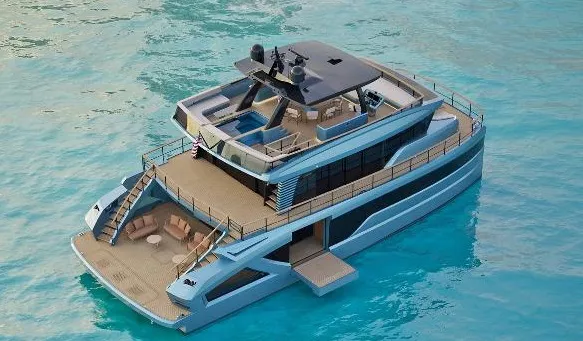Sailing catamarans are renowned for their stability and speed, attributes that make them popular choices for both recreational sailors and commercial ventures. However, despite their design advantages, questions often arise regarding their susceptibility to capsizing. Understanding the factors that influence a catamaran‘s stability is crucial for safe operation and informed decision-making.
Can Catamarans Capsize?
What is a Catamaran?
A catamaran is a type of boat featuring two parallel hulls of equal size. This design provides a wide beam, contributing to enhanced stability compared to monohull vessels. The separation of the hulls reduces the likelihood of heeling (leaning to one side) and, under normal conditions, makes capsizing less probable.
How Do Catamarans Stay Stable?
Catamarans rely on their form stability, derived from their hull configuration, to resist heeling and capsizing. The wide stance of the hulls offers significant initial resistance to heeling. For instance, a cruising catamaran requires four times the force to initiate a capsize compared to an equivalent monohull.
Factors That Can Lead to Capsizing
While catamarans are designed for stability, certain conditions and actions can increase the risk of capsizing:
1. Wave Height
High waves can pose a threat to catamarans. If a wave causes the bow to submerge (a phenomenon known as “pitch-poling”), it can lead to a loss of stability and potential capsizing. However, such events are rare and can often be prevented by monitoring weather conditions and adjusting course accordingly.
2. Wind Speed
Strong winds exert greater pressure on a catamaran’s sails, increasing the heeling force. If the wind’s force surpasses the crew’s ability to manage the sails and balance the boat, capsizing becomes a risk. Proper sail management and reefing (reducing sail area) are essential in windy conditions to maintain control.
3. Weather Conditions
Severe weather, including storms and squalls, significantly heightens the risk of capsizing. Sudden gusts and unpredictable waves can challenge even experienced sailors. It’s crucial to check weather forecasts before setting sail and to be prepared to seek shelter if conditions deteriorate.
4. Breaking Waves
Breaking waves release substantial energy that can overwhelm a catamaran’s stability. Encountering such waves, especially at high speeds, can lead to capsizing. Avoiding areas with breaking waves and navigating at appropriate speeds are key preventive measures.
5. Operational Factors
Factors such as improper weight distribution, overloading, and inadequate crew training can compromise a catamaran’s stability. Ensuring even weight distribution, avoiding excessive loading, and having a well-trained crew are vital for safe operation.
Notable Capsizing Incidents
While rare, there have been instances where catamarans have capsized, often due to extreme conditions or operational errors:
- 2009 Kiribati Ferry Accident: A double-hulled catamaran capsized in high seas when the captain attempted to turn around to rescue a crew member who had been swept overboard. The incident resulted in the loss of 33 lives.
- 2017 Mengalum Island Boat Accident: A catamaran ferry sank off Mengalum Island in Malaysia, leading to four confirmed deaths and five missing persons.
These incidents highlight the importance of adhering to safety protocols, understanding vessel capabilities, and respecting environmental conditions.
Safety Measures to Prevent Capsizing
To minimize the risk of capsizing, catamaran operators should implement the following safety measures:
1. Ensure Proper Weight Distribution
Distribute weight evenly across the catamaran, keeping heavier items low and centered. This practice enhances stability and reduces the likelihood of capsizing.
2. Learn and Practice Reefing Techniques
Reefing involves reducing the sail area to adapt to changing wind conditions. Proper reefing techniques help maintain control and prevent excessive heeling in strong winds.
3. Utilize Appropriate Anchoring Techniques
Understanding how to anchor securely prevents the catamaran from drifting in strong currents or winds, reducing the risk of capsizing.
4. Use the Engine When Necessary
In challenging conditions, using the engine can provide additional stability and control, helping to prevent capsizing.
5. Maintain Stabilizing Devices
Ensure that keels, daggerboards, and centerboards are properly installed and maintained, as they play a crucial role in preventing capsizing.
6. Deploy Drogues in Heavy Seas
A drogue is a device that can help slow down the boat and prevent it from capsizing in heavy seas. Learning how to properly use a drogue is essential for sailors venturing into rough waters.
7. Equip the Catamaran with Safety Gear
Always carry essential safety equipment, including life jackets, flares, and a first aid kit. Ensure that all crew members are familiar with the location and use of this equipment.
8. Consider Using an Autopilot
An autopilot system is a self-steering device that can hold your vessel on a pre-set compass course, reducing the need for constant manual steering. For catamarans, especially those venturing into open waters, investing in a reliable autopilot system is essential for both safety and convenience. Modern autopilots, such as the Pelagic Autopilot System, utilize advanced technology to monitor and predict boat movement, ensuring stable and accurate course-keeping in various sea conditions.
Drogues: Enhancing Stability in Rough Seas
A drogue is a device towed from the stern to limit the boat’s speed and keep the stern facing the waves, thereby enhancing stability and reducing the risk of capsizing. Deploying a drogue can be especially beneficial in heavy seas and storm conditions. The Jordan Series Drogue, for example, is designed to prevent capsizing and damage to both monohull and multihull vessels operating in open ocean conditions.
Conclusion
While catamarans are inherently more stable than monohull vessels, understanding the factors that can lead to capsizing is crucial for safe operation. By implementing appropriate safety measures, such as ensuring proper weight distribution, learning reefing techniques, utilizing stabilizing devices like drogues, and equipping the vessel with reliable autopilot systems, sailors can significantly reduce the risk of capsizing and enhance their overall sailing experience.

